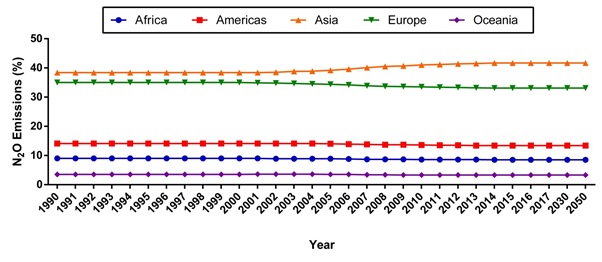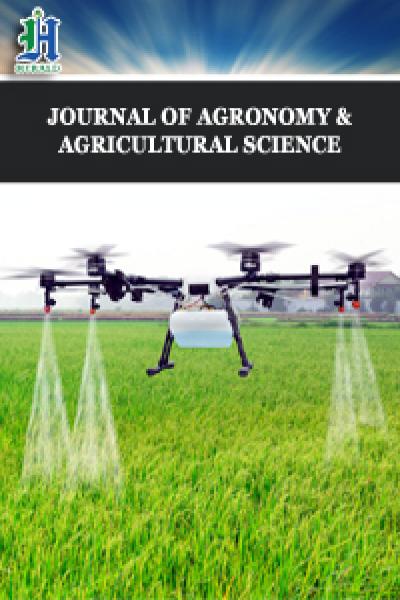
Nitrous Oxide (N2 O) Emissions from Organic Crops
*Corresponding Author(s):
Dutra JCVDepartment Of Biological Sciences, Federal University Of Espírito Santo, Espírito Santo, Brazil
Tel:+55 02740092222,
Email:jeanvencioneck@gmail.com
Abstract
Recently, organic agriculture has been recognized in the world as a farming sustainably. Organic trade is a growing reality all over the worlds and are entering mainstream markets of agronomy. Farming is responsible to the emission of several greenhouse gases, such as carbon dioxide (CO2) and nitrous oxide (N2O). N2O may accelerate global warming and contribute to the destruction of ozone in the stratosphere, and reduce its emission on agriculture is necessary. To achieve this goal, changes in human diet and agricultural practices are required, and way to encourage farmers to reduce the use of nitrogen fertilizers would be to create a certification for nitrogen use efficiency in the crops, which could add more value to organic crops.
Keywords
Crop certification; Global warming; Greenhouse gases; Nitrogen use efficiency
INTRODUCTION
Organic agriculture has been popularized in recent years as sustainable farming. Organic trade is a growing reality all over the world and their growth rates suggest that organic products are entering mainstream markets of agronomy [1]. The organic food sector development has been related to the fast increase of conversion to organic on the farm level in the world. Some countries have been outstanding due to the increase in organic cultivation, e.g. about 15.000 farmers are classified as organic in Germany, as well as organic crops reached the range of 10 % in Switzerland and Austria, and similar proportions in Sweden and Finland [1].
In organic farming, as in conventional agriculture, there are the emission of several gases, such as carbon dioxide (CO2) and nitrous oxide (N2O). Both gases classified as greenhouse gases and N2O has been reported as one of the most important greenhouse gases due to its global warming potential [2] and its contribution to the destruction of ozone in the stratosphere [3]. Since the mid-twentieth century the atmospheric N2O has risen from approximately 290 ppb in 1940 to 330 ppb in 2017 [3-6], which is strongly related to the amount of Reactive Nitrogen (Nr) in the environment [7,8].
Agriculture, energy use, industrial processes and waste management was indicated as the major sources of N2O emissions in United States [9], being agriculture responsible for the largest source, 73 % of N2O emissions, likewise the majority of agricultural emissions results from nitrogen fertilization of agricultural soils, 87 % of the agriculture total [9]. Even using less nitrogen compounds in the crop, organic crops also contribute to the emission of greenhouse gases. Agricultural N2O emissions into the atmosphere have increased and estimated by Food and Agriculture Organization (FAO). Following FAO estimates, Asia and Europe are the continents with the highest N2O emissions in organic farming since 1990 (Figure 1).
 Figure 1: N2O emissions from organic crops by continents along the years.
Figure 1: N2O emissions from organic crops by continents along the years.
Percentage corresponds to N2O emissions equivalent to CO2 in total cropland and grassland organic soils. The percentage shown in 2030 and 2050 corresponds to projections established by FAO. All data was provided by FAO database (http://www.fao.org/faostat/en/#data/GV/visualize).
Aneja and collaborators also suggest that the intensive use of fertilizer increased the emissions of Nr compounds, such as N2O from soils through nitrification and gentrification processes [10], which may accelerate the advance of the greenhouse effect. The emissions of N2O increased from 10-12TgNyr-1 (before industrial era) to an average of ~17TgNyr-1 (last decade) [7,11]. Regarding to the meet climate goals, reductions of the emission of non-CO2 greenhouse gases are also require [12]. It implies in changes in human diet and agricultural practices, which means reduce agricultural emissions of N2O while meeting the growing demand for food and other agricultural products, that is, improve nitrogen use efficiency in the crops, increasing Nr in harvest relative to nitrogen input [13,14].
FINAL CONSIDERATIONS
Climate changes lead to a range of potential ecological, physical and health impacts. Greenhouse gases are strongly related to these impacts and may accelerates extreme weather events, such as floods, droughts, storms, heat waves, sea-level rise, disrupt water systems and alter crop growth [15]. Changes in human diet and agricultural practices, mainly in the agricultural emissions of N2O, are necessary to reduce greenhouse gas emissions. Improve nitrogen use efficiency in the crops may be the key to increase Nr in harvest relative to nitrogen input. However, proposing changes to agricultural sectors is not easy. One way to encourage farmers to reduce their use of nitrogen fertilizers would be, for example, to create a certification for nitrogen use efficiency in the crops, which could add more value to organic crops. However, further studies would be needed on the parameters to be used for this type of certification.
REFERENCES
- Geier B (1987) An overview and facts on worldwide organic agriculture organic trade a growing reality.
- Myhre G, Shindell D (2013) Anthropogenic and natural radiative forcing. In: Stocker TF, QinD, Plattner GK, Tignor M, Allen SK, et al. (Eds.). Climate change 2013: The physical science basis. Contribution of working group i to the fifth assessment report of the intergovernmental panel on climate change,. Cambridge University Press, Cambridge, New York, USA.
- Ravishankara AR, Daniel JS, Portmann RW (2009) Nitrous Oxide (N2O): The dominant ozone-depleting substance emitted in the 21st century. 326:123-125.
- Ciais P, Sabine C, Bala G, Bopp L, Brovkin V, et al. (2013) Contribution of working group i to the fifth assessment report of the intergovernmental panel on climate change.
- Park S, Croteau P, Boering KA, Etheridge DM, Ferretti D, et al. (2012) Trends and seasonal cycles in the isotopic composition of nitrous oxide since 1940. Nat Geosci 5: 261-265.
- Water WC (2018) WMO greenhouse gas bulletin. World Meteorological Organization, Geneva, Switzerland.
- Davidson EA (2009) The contribution of manure and fertilizer nitrogen to atmospheric nitrous oxide. Nat Geosci 2: 659.
- Bouwman AF, Beusen AHW, Griffioen J, Van Groenigen JW, Hefting MM, et al. (2013) Global trends and uncertainties in terrestrial denitrification and N2O emissions. Philos Trans R Soc B Biol Sci 368: 20130112.
- EIA US (2009) Emissions of greenhouse gases in the United States. US Energy.
- Aneja VP, Schlesinger WH, Li Q, Nahas A, Battye WH (2019) Characterization of atmospheric nitrous oxide emissions from global agricultural soils. SN Appl Sci 1: 1662.
- Syakila A, Kroeze C (2011) The global nitrous oxide budget revisited. Greenh Gas Meas Manag 1: 17-26.
- IPCC (2018) Summary for Policymakers. In: Masson-Delmotte VP, Zhai HO, Pörtner D, Roberts J, Skea PR, et al. (eds.) Global warming of 1.5°C. An IPCC special report on the impacts of global warming of 1.5°C above pre-industrial levels and related global greenhouse gas emission pathways, in the context of strengthening the global response to the threat of climate change, sustainable development, and efforts to eradicate poverty. World Meteorological Organization, Geneva, Switzerland. Pg no: 32.
- Davidson EA, Suddick EC, Rice CW, Prokopy LS (2015) More Food, Low Pollution (Mo Fo Lo Po): A grand challenge for the 21st century. J Environ Qual 44: 305-311.
- Springmann M, Clark M, Mason-D’Croz D, Wiebe K, Bodirsky BL, et al. (2018) Options for keeping the food system within environmental limits. Nature 562: 519-525.
- Field CB (2014) Climate change 2014-Impacts, adaptation and vulnerability: Regional aspects. Cambridge University Press, Cambridge, UK.
Citation: Dutra JCV (2020) Nitrous Oxide (N2O) Emissions from Organic Crops. J Agron Agri Sci 3: 018.
Copyright: © 2020 Dutra JCV, et al. This is an open-access article distributed under the terms of the Creative Commons Attribution License, which permits unrestricted use, distribution, and reproduction in any medium, provided the original author and source are credited.

